 W
WHydroxide is a diatomic anion with chemical formula OH−. It consists of an oxygen and hydrogen atom held together by a covalent bond, and carries a negative electric charge. It is an important but usually minor constituent of water. It functions as a base, a ligand, a nucleophile, and a catalyst. The hydroxide ion forms salts, some of which dissociate in aqueous solution, liberating solvated hydroxide ions. Sodium hydroxide is a multi-million-ton per annum commodity chemical. A hydroxide attached to a strongly electropositive center may itself ionize, liberating a hydrogen cation (H+), making the parent compound an acid.
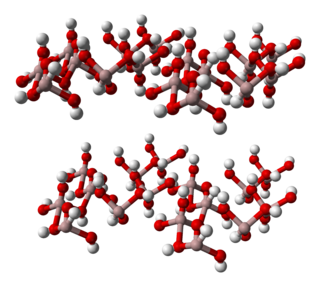 W
WAluminium hydroxide, Al(OH)3, is found in nature as the mineral gibbsite (also known as hydrargillite) and its three much rarer polymorphs: bayerite, doyleite, and nordstrandite. Aluminium hydroxide is amphoteric in nature, i.e., it has both basic and acidic properties. Closely related are aluminium oxide hydroxide, AlO(OH), and aluminium oxide or alumina (Al2O3), the latter of which is also amphoteric. These compounds together are the major components of the aluminium ore bauxite.
 W
WBarium hydroxide is a chemical compound with the chemical formula Ba(OH)2(H2O)x. The monohydrate (x =1), known as baryta or baryta-water, is one of the principal compounds of barium. This white granular monohydrate is the usual commercial form.
 W
WBenzyltrimethylammonium hydroxide, also known as Triton B or trimethylbenzylammonium hydroxide, is a quaternary ammonium salt that functions as an organic base. It is usually handled as a solution in water or methanol. The compound is colourless, although the solutions often appear yellowish. Commercial samples often have a distinctive fish-like odour, presumably due to the presence of trimethylamine via hydrolysis.
 W
WBeryllium hydroxide, Be(OH)2, is an amphoteric hydroxide, dissolving in both acids and alkalis. Industrially, it is produced as a by-product in the extraction of beryllium metal from the ores beryl and bertrandite. The natural pure beryllium hydroxide is rare (in form of the mineral behoite, orthorhombic) or very rare (clinobehoite, monoclinic). When alkali is added to beryllium salt solutions the α-form (a gel) is formed. If this left to stand or boiled, the rhombic β-form precipitates. This has the same structure as zinc hydroxide, Zn(OH)2, with tetrahedral beryllium centers.
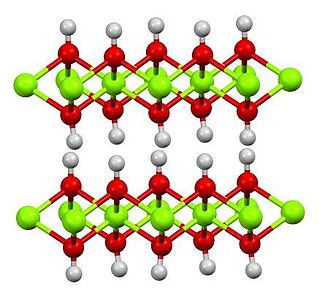 W
WCadmium hydroxide is an inorganic compound with the formula Cd(OH)2. It is a white crystalline ionic compound that is a key component of NiCd batteries.
 W
WCaesium hydroxide or cesium hydroxide (CsOH) is a chemical compound consisting of caesium ions and hydroxide ions. It is a strong base (pKb=-1.76), much like the other alkali metal hydroxides such as sodium hydroxide and potassium hydroxide. In fact, caesium hydroxide is corrosive enough to dissolve through glass quickly.
 W
WCalcium hydroxide (traditionally called slaked lime) is an inorganic compound with the chemical formula Ca(OH)2. It is a colorless crystal or white powder and is produced when quicklime (calcium oxide) is mixed, or slaked with water. It has many names including hydrated lime, caustic lime, builders' lime, slack lime, cal, or pickling lime. Calcium hydroxide is used in many applications, including food preparation, where it has been identified as E number E526. Limewater is the common name for a saturated solution of calcium hydroxide.
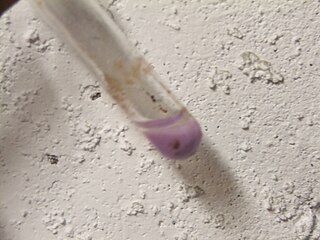 W
WCobalt(II) hydroxide or cobaltous hydroxide is the inorganic compound with the formula Co(OH)2, consisting of divalent cobalt cations Co2+ and hydroxide anions HO−. The pure compound, often called the "beta form" is a pink solid insoluble in water.
 W
WCopper(II) hydroxide is the hydroxide of copper with the chemical formula of Cu(OH)2. It is a pale greenish blue or bluish green solid. Some forms of copper(II) hydroxide are sold as "stabilized" copper(II) hydroxide, although they likely consist of a mixture of copper(II) carbonate and hydroxide. Cupric hydroxide is a weak base.
 W
WCurium hydroxide [Cm(OH)3] is a radioactive compound first discovered in measurable quantities in 1947. It is composed of a single curium atom, and three hydroxide groups. It was the first curium compound ever isolated.
 W
WDysprosium(III) hydroxide is an inorganic compound with the chemical formula Dy(OH)3.
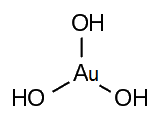 W
WGold(III) hydroxide, gold trihydroxide, or gold hydroxide is an inorganic compound, a hydroxide of gold, with formula Au(OH)3. It is also called auric acid with formula H3AuO3. It is easily dehydrated above 140 °C to gold(III) oxide. Salts of auric acid are termed aurates.
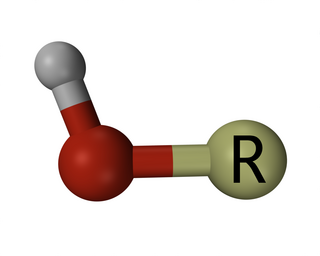 W
WA hydroxy or hydroxyl group is the entity with the formula OH. It contains oxygen bonded to hydrogen. In organic chemistry, alcohols and carboxylic acids contain hydroxy groups. Both the negatively charged anion OH−, called hydroxide, and the neutral radical ·OH, known as the hydroxyl radical, consist of an unbounded hydroxyl group.
 W
WThe hydroxyl radical, •OH, is the neutral form of the hydroxide ion (OH−). Hydroxyl radicals are highly reactive (easily becoming hydroxy groups) and consequently short-lived; however, they form an important part of radical chemistry. Most notably hydroxyl radicals are produced from the decomposition of hydroperoxides (ROOH) or, in atmospheric chemistry, by the reaction of excited atomic oxygen with water. It is also an important radical formed in radiation chemistry, since it leads to the formation of hydrogen peroxide and oxygen, which can enhance corrosion and SCC in coolant systems subjected to radioactive environments. Hydroxyl radicals are also produced during UV-light dissociation of H2O2 (suggested in 1879) and likely in Fenton chemistry, where trace amounts of reduced transition metals catalyze peroxide-mediated oxidations of organic compounds.
 W
WIron(II) hydroxide or ferrous hydroxide is an inorganic compound with the formula Fe(OH)2. It is produced when iron(II) salts, from a compound such as iron(II) sulfate, are treated with hydroxide ions. Iron(II) hydroxide is a white solid, but even traces of oxygen impart a greenish tinge. The air-oxidised solid is sometimes known as "green rust".
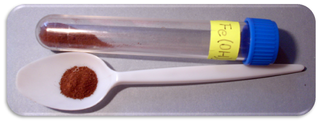 W
WIron(III) oxide-hydroxide or ferric oxyhydroxide is the chemical compound of iron, oxygen, and hydrogen with formula FeO(OH).
 W
WLanthanum hydroxide is La(OH)3, a hydroxide of the rare-earth element lanthanum.
 W
WLayered double hydroxides (LDH) are a class of ionic solids characterized by a layered structure with the generic layer sequence [AcB Z AcB]n, where c represents layers of metal cations, A and B are layers of hydroxide anions, and Z are layers of other anions and neutral molecules. Lateral offsets between the layers may result in longer repeating periods.
 W
WLimewater is the common name for a dilute aqueous solution of calcium hydroxide. Calcium hydroxide, Ca(OH)2, is sparsely soluble at room temperature in water (1.5 g/L at 25 °C). "Pure" (i.e. less than or fully saturated) limewater is clear and colorless, with a slight earthy smell and an astringent/bitter taste. It is basic in nature with a pH of 12.4.
 W
WLithium hydroxide is an inorganic compound with the formula LiOH. It is a white hygroscopic crystalline material. It is soluble in water and slightly soluble in ethanol, and is available commercially in anhydrous form and as the monohydrate (LiOH.H2O). While lithium hydroxide is a strong base, it is the weakest known alkali metal hydroxide.
 W
WA lye is a metal hydroxide traditionally obtained by leaching wood ashes, or a strong alkali which is highly soluble in water producing caustic basic solutions. "Lye" most commonly refers to sodium hydroxide (NaOH), but historically has been used for potassium hydroxide (KOH).
 W
WMagnesium hydroxide is the inorganic compound with the chemical formula Mg(OH)2. It occurs in nature as the mineral brucite. It is a white solid with low solubility in water (Ksp = 5.61×10−12). Magnesium hydroxide is a common component of antacids, such as milk of magnesia, as well as laxatives.
 W
WNickel(II) hydroxide is the inorganic compound with the formula Ni(OH)2. It is an apple-green solid that dissolves with decomposition in ammonia and amines and is attacked by acids. It is electroactive, being converted to the Ni(III) oxy-hydroxide, leading to widespread applications in rechargeable batteries.
 W
WPotassium hydroxide is an inorganic compound with the formula KOH, and is commonly called caustic potash.
 W
WWater is a polar inorganic compound that is at room temperature a tasteless and odorless liquid, which is nearly colorless apart from an inherent hint of blue. It is by far the most studied chemical compound and is described as the "universal solvent" and the "solvent of life." It is the most abundant substance on Earth and the only common substance to exist as a solid, liquid, and gas on Earth's surface. It is also the third most abundant molecule in the universe.
 W
WSchweizer's reagent is the metal ammine complex with the formula [Cu(NH3)4(H2O)2](OH)2. This deep-blue compound is used in purifying cellulose.
 W
WSoda lime is a mixture of NaOH & Ca(OH)2 chemicals, used in granular form in closed breathing environments, such as general anaesthesia, submarines, rebreathers and recompression chambers, to remove carbon dioxide from breathing gases to prevent CO2 retention and carbon dioxide poisoning.
 W
WSodium hydroxide, also known as lye and caustic soda, is an inorganic compound with the formula NaOH. It is a white solid ionic compound consisting of sodium cations Na+ and hydroxide anions OH−.
 W
WSodium stannate, formally sodium hexahydroxostannate(IV), is the inorganic compound with the formula Na2[Sn(OH)6]. This colourless salt forms upon dissolving metallic tin or tin(IV) oxide in sodium hydroxide, and is used as a stabiliser for hydrogen peroxide. In older literature, stannates are sometimes represented as having the simple oxyanion SnO32−, in which case this compound is sometimes named as sodium stannate–3–water and represented as Na2SnO3·3H2O, a hydrate with three waters of crystallisation. The anhydrous form of sodium stannate, Na2SnO3, is recognised as a distinct compound with its own CAS Registry Number, 12058-66-1, and a distinct material safety data sheet.
 W
WStrontium hydroxide, Sr(OH)2, is a caustic alkali composed of one strontium ion and two hydroxide ions. It is synthesized by combining a strontium salt with a strong base. Sr(OH)2 exists in anhydrous, monohydrate, or octahydrate form.
 W
WTetrabutylammonium hydroxide is the chemical compound with the formula (C4H9)4NOH, abbreviated Bu4NOH with the acronym TBAOH or TBAH. This species is employed as a solution in water or alcohols. It is a common base in organic chemistry. Relative to more conventional inorganic bases, such as KOH and NaOH, Bu4NOH is more soluble in organic solvents.
 W
WTetraethylammonium hydroxide is the organic compound with the formula (C2H5)4NOH, abbreviated Et4NOH. It is the tetraethylammonium salt of hydroxide. It is used and dispensed as solutions in water or alcohols, which are colorless and highly alkaline. The compound is a common reagent in organic synthesis. It is also employed in the preparation of zeolites.
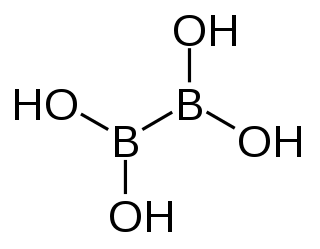 W
WTetrahydroxydiboron is a chemical reagent which can be used to prepare boronic acids.
 W
WTetramethylammonium hydroxide (TMAH or TMAOH) is a quaternary ammonium salt with the molecular formula N(CH3)4+ OH−. It is commonly encountered as concentrated solutions in water or methanol. The solid and solutions are colorless, or yellowish if impure. Although TMAH has virtually no odor when pure, samples often have a strongly fishy smell from the trimethylamine which is a common impurity. TMAH has numerous and diverse industrial and research applications.
 W
WThallium(I) hydroxide, also called thallous hydroxide, TlOH, is a hydroxide of thallium, with thallium in oxidation state +1. Thallous hydroxide is a strong base; it is changed to thallous ion, Tl+, except in strongly basic conditions. Tl+ resembles an alkali metal ion, A+, such as Li+ or K+.
 W
WThulium(III) hydroxide is an inorganic compound with the chemical formula Tm(OH)3.
 W
WTin(II) hydroxide, Sn(OH)2, also known as stannous hydroxide, is an inorganic compound tin(II). The only related material for which definitive information is available is the oxy hydroxide Sn6O4(OH)4, but other related materials are claimed. They are all white solids that are insoluble in water.
 W
WTitanic acid is a general name for a family of chemical compounds of the elements titanium, hydrogen, and oxygen, with the general formula [TiOx(OH)4−2x]n. Various simple titanic acids have been claimed, mainly in the older literature. No crystallographic and little spectroscopic support exists for these materials. Some older literature including Brauer's Handbook refers to TiO2 as titanic acid.Metatitanic acid (H2TiO3), Orthotitanic acid (H4TiO4). It is described as a white salt-like powder under "TiO2·2.16H2O." Peroxotitanic acid (Ti(OH)3O2H) has also been described as resulting from the treatment of titanium dioxide in sulfuric acid with hydrogen peroxide. The resulting yellow solid decomposes with loss of O2. Pertitanic acid (H2TiO4) Pertitanic acid (TiO(H2O2)2+)
 W
WUranyl hydroxide is a hydroxide of uranium with the chemical formula UO2(OH)2 in the monomeric form and (UO2)2(OH)4 in the dimeric; both forms may exist in normal aqueous media. Uranyl hydroxide hydrate is precipitated as a colloidal yellowcake from oxidized uranium liquors near neutral pH.